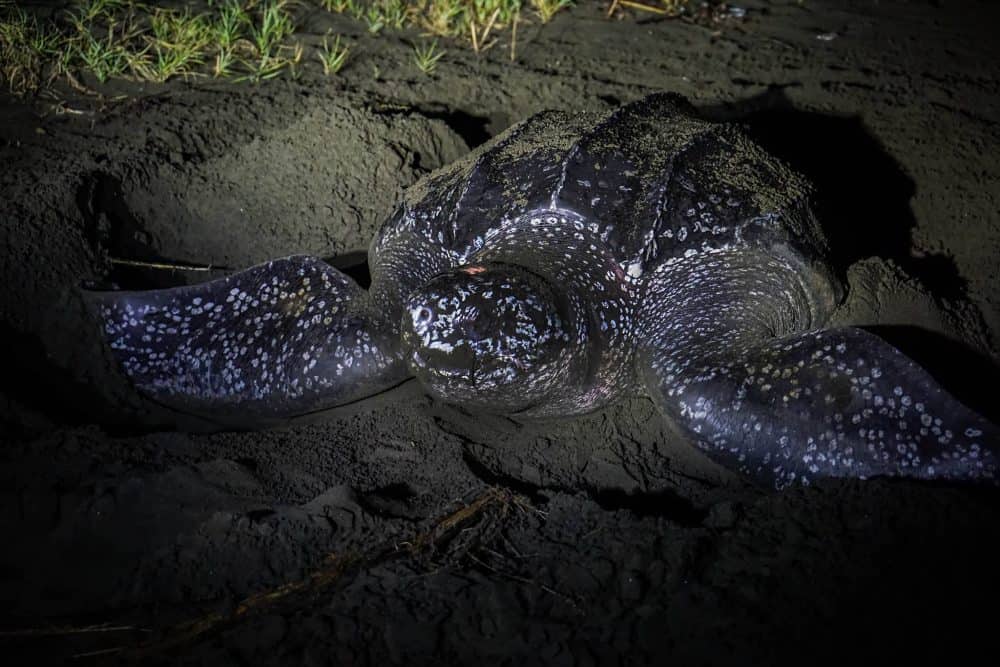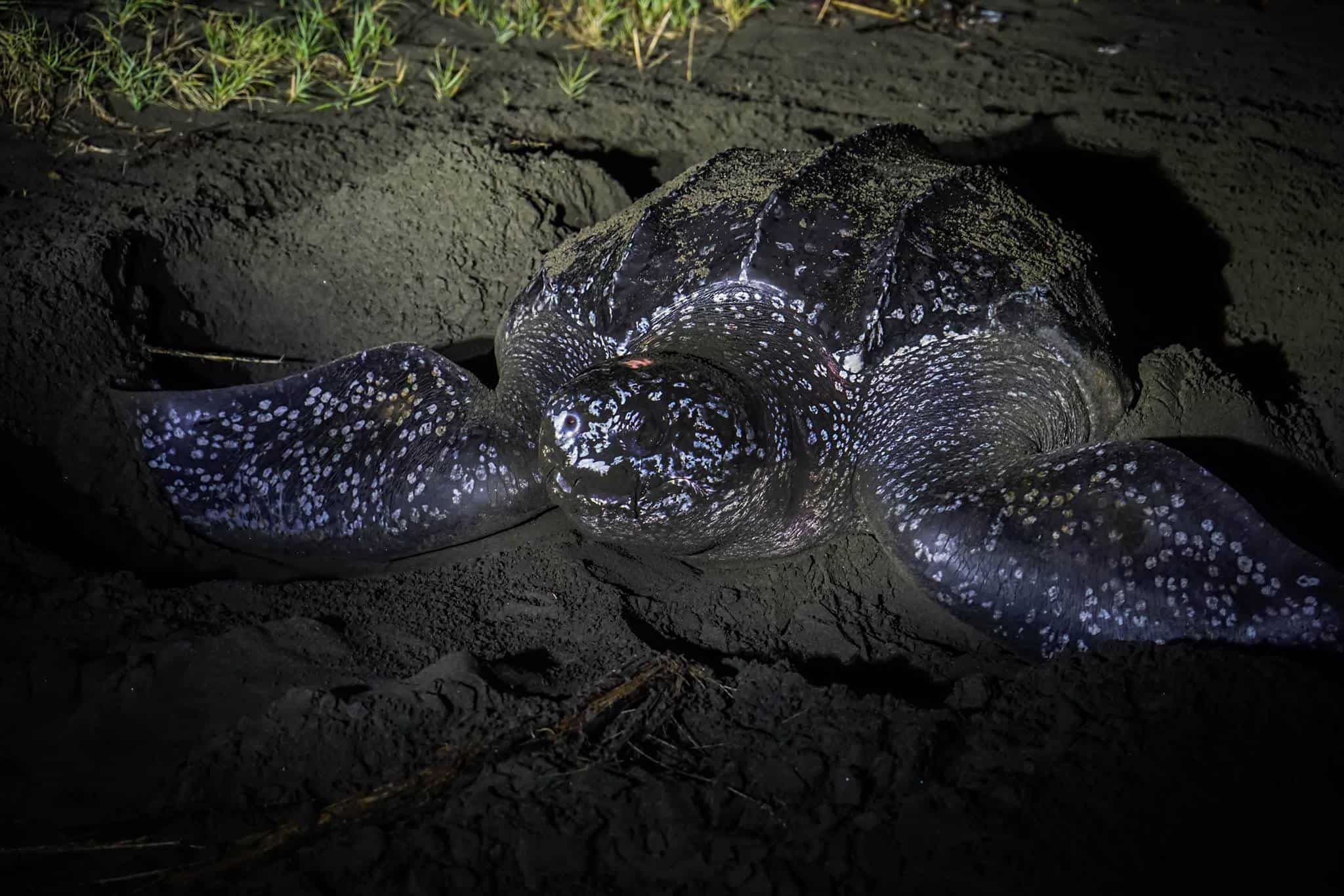Baby sea turtles can’t get a break. Poachers and wild animals snatch up their eggs before they can hatch, and when they do break out of their shells they have to dig through 80 centimeters of sand and crawl to the water to face the toothy, hungry horrors of the oceans all alone.
Now, a recently published study shows that successful hatches of baby turtles in Playa Grande, on the northwestern coast of Costa Rica, are likely to decline by as much as 50 to 60 percent as temperatures rise and rainfall diminishes in crucial nesting areas.
“This is very bad news for the leatherback sea turtle, at least in this area,” said Pilar Santidrián Tomillo, science director for The Leatherback Trust, a sea turtle conservation group. “Unless climatic conditions are reverted we may have to move eggs to climate-controlled hatcheries; we may have to shade nests or water nests [to ensure successful hatchings].”
Leatherback sea turtles (Dermochelys coriacea) are the largest marine turtles, growing as large as 500 kilograms. They are critically endangered with an estimated global population of about 30,000. Pacific leatherbacks are the most threatened of the leatherbacks with only about 2,000 turtles nesting at the most important nesting areas in Costa Rica and Mexico.
Baby sea turtles that survive egg poachers, make it to the sea and don’t get eaten by crocodiles or sharks face a lifelong threat of being caught up in industrial fishing nets or longlines, which stretch out with studded with baited hooks across tens of kilometers.

The study, “Climate-Driven Egg and Hatchling Mortality Threatens Survival of Eastern Pacific Leatherback Turtles,” examined hatching success rates in leatherback nests at Playa Grande near Las Baulas National Marine Park, and used climate-change predictions from the International Panel on Climate Change (IPCC) to project egg and hatchling survival rates through the end of the century. IPCC climate predictions indicate that the effects of climate change will cause hotter, drier weather in the northwestern part of Costa Rica while other parts, particularly the Caribbean coast, will see increases in rainfall as the century progresses.
But how hot is too hot for the baby leatherbacks?
“Within the nest, clutches with average temperatures above 33-34 degrees Celsius don’t seem to hatch,” said Santidrián. “For air temperatures, it’s different, since rainfall is the most important factor affecting hatching success, and it has a cooling effect in the nest. In general, it seems that our model predicted approximately 0 percent hatching success for air temperatures above 32 degrees [C], … [depending] on precipitation.”
The Economic Commission for Latin America and the Caribbean (ECLAC) released a report in San José this past March, which predicts a minimum average temperature increase in Central America of 2.4 C by 2100. That projection is based on a worldwide best-case scenario. The upper end of the ECLAC projections, which are also based on IPCC data, indicate a potential 4 C average temperature increase in the region (TT, March 2).
Current average temperatures at Tamarindo, near Las Baulas, vacillate between lows of about 22 C and highs of 29 C in the cooler months of the year, and lows of 24 C and highs of 34 C in warmer months.
Leatherbacks nest at Playa Grande from October to February, and the eggs take approximately 60 days to hatch, meaning many clutches hatch during the warmest months of the year.
The projections don’t look good for the future of leatherback eggs and hatchlings – the ECLAC report predicts hatchling survival will “rapidly decline in the region over the next 100 years by 50-60 percent, due to warming and drying in northwestern Costa Rica, threatening the survival of leatherback turtles.”
More heat means more females
Temperature also affects the sex of hatching sea turtles. Santidrián said the middle point for sex determination in leatherback turtles at Playa Grande is 29.4 C. Temperatures warmer than that churn out lots of baby girl turtles and temperatures below that mean it will be mostly boys charging for the oceans upon hatching.
According to the report, Playa Grande leatherback females nest on average seven times per season. They lay clutches of approximately 50-120 eggs that incubate at a depth of 80 centimeters beneath the sand, according to the conservation group WWF.
Leatherback nesting and hatching cycles depend on periodic El Niño and La Niña weather patterns to stagger “boom and bust” hatches of male and female turtles – El Niño years are warmer and drier resulting in more females, and La Niña years are cooler and wetter, resulting in more males. As annual average temperatures rise steadily over the course of the next 88 years, though, the trend predicts many more booming seasons for females and a paucity of male-heavy hatches with obvious, negative implications for the species as a whole.
Why do they matter?
Besides being the world’s largest sea turtles, the oldest living reptiles, and their ability to dive to depths of 1,200 meters, what’s the big deal about leatherback sea turtles?
“They feed mainly on jellyfish,” Santidrián said. “So, for example, in places like the Mediterranean where turtles are disappearing, there are jellyfish blooms every year reaching very developed beaches, where there are a lot of swimmers in the water.”
Besides being a painful end to a day of surf and sun, jellyfish stings can lead to anaphylactic shock and death.
Jellyfish sometimes feed on fish larvae, which can have big impacts on commercially viable fish species when jellyfish populations are out of equilibrium.
“Jellyfish sometimes compete with fish, so when you see jellyfish increase other fish species may decrease,” Santidrián said. “Everything about a species is very tied to their ecosystem, and when you remove them there are always consequences.”
In Playa Grande, local residents – some of them reformed poachers – work as guides for tourists who visit Costa Rica specifically to see nesting or hatching turtles. The tourists bring economic opportunities with them.
“For a country that has a reputation as a conservationist country, to let a species go extinct is not a good thing,” Santidrián warned.
What now?
Santidrián said she remains optimistic that the leatherback sea turtle can be saved, but the fact remains that there’s not much Costa Rica can do to offset this particular threat to its turtles. Central American countries produce only 0.3 percent of the world’s greenhouse gas emissions, but due to high poverty, poor infrastructure and long stretches of low-lying coastal areas, the region will bear a disproportionate amount of the negative effects of rising global temperatures and sea levels (TT, March 2).
As temperatures continue to rise throughout the rest of the century, Santidrián said, some short-term actions like manually watering or shading nests or moving eggs to climate-controlled incubators might give leatherbacks a better shot at survival.
But, she admits, these are stopgap measures.
“I think that this is sort of a final warning,” Santidrián said. “There is still a way out, but we have to start taking this very seriously.”







